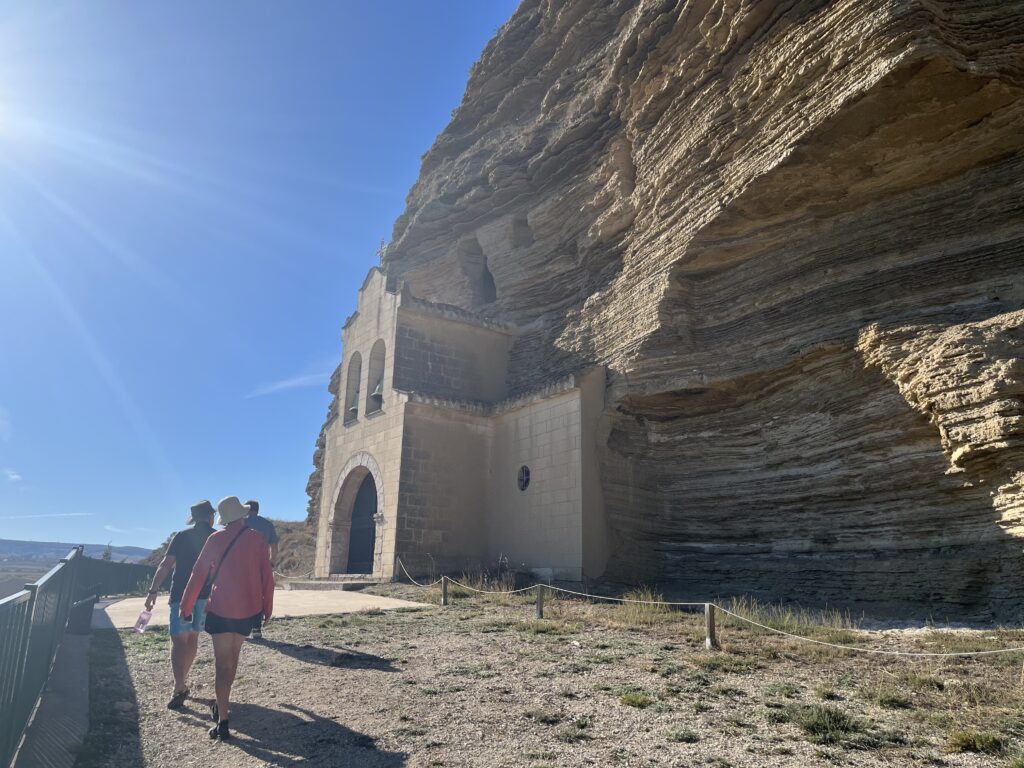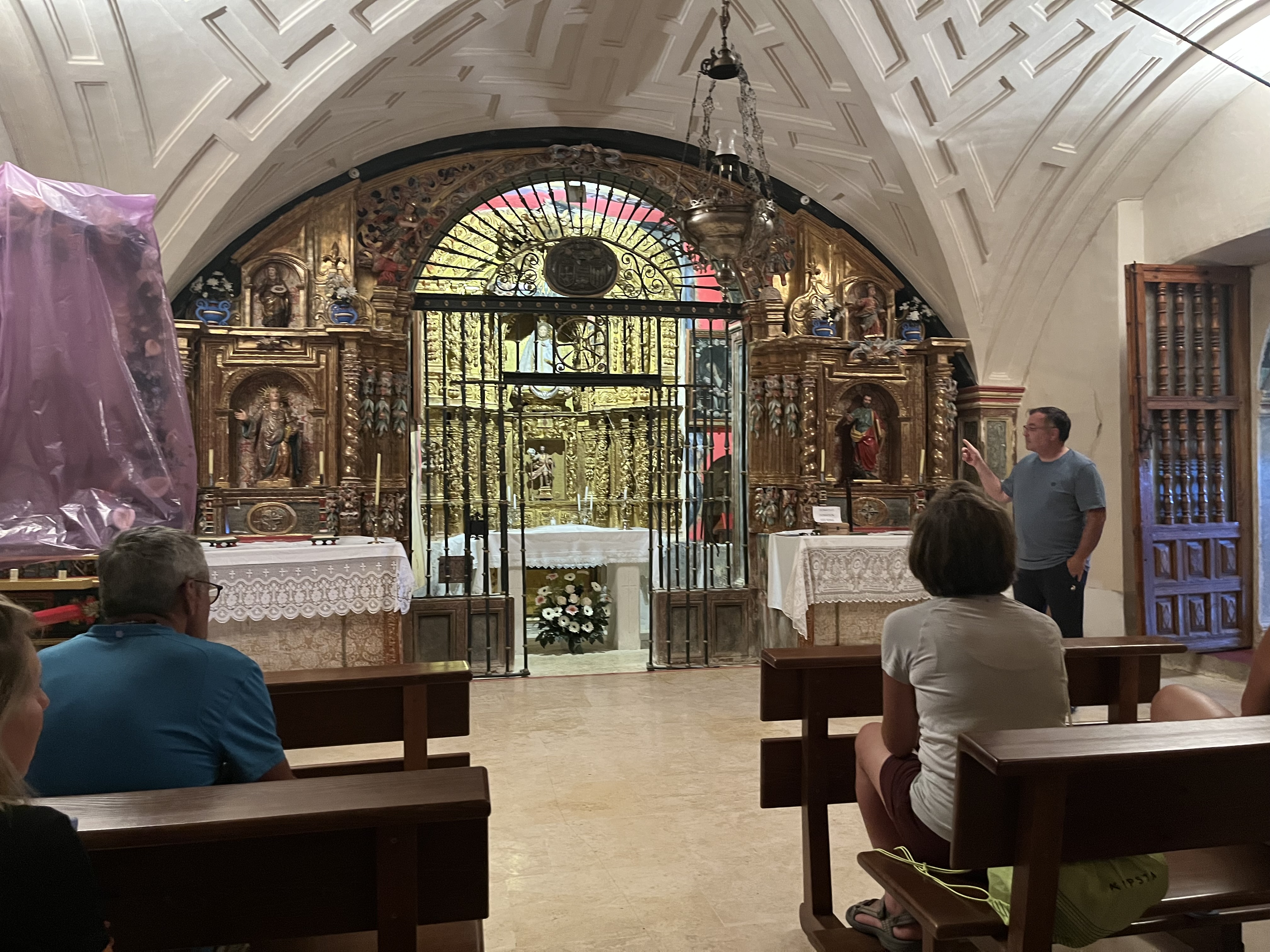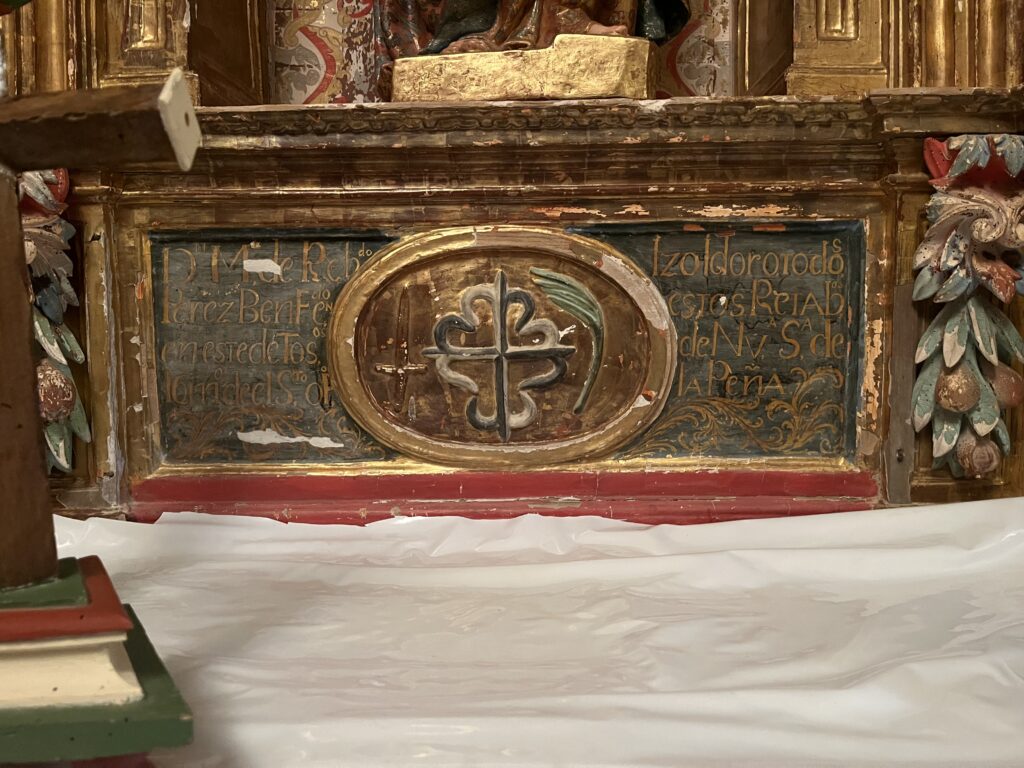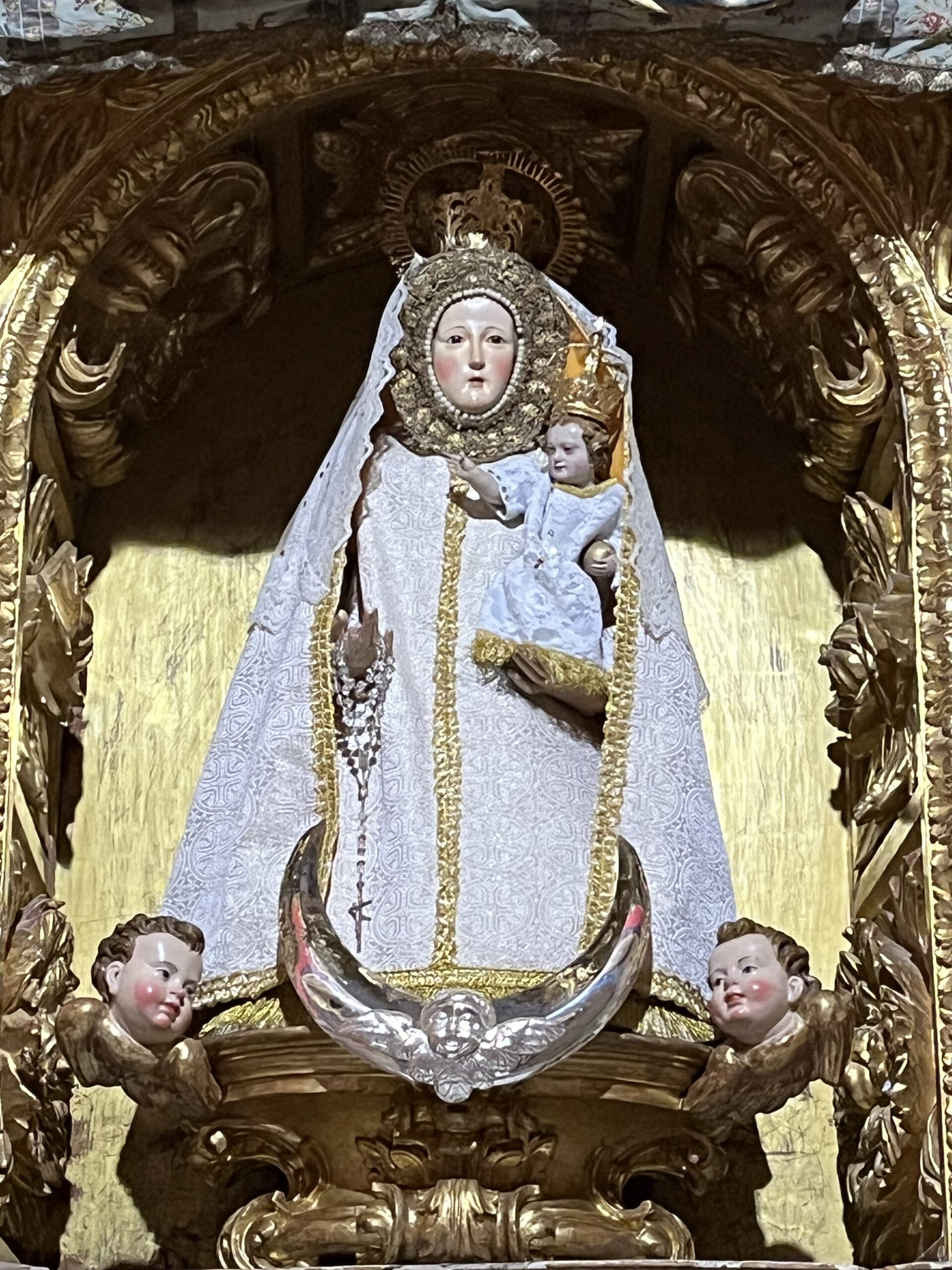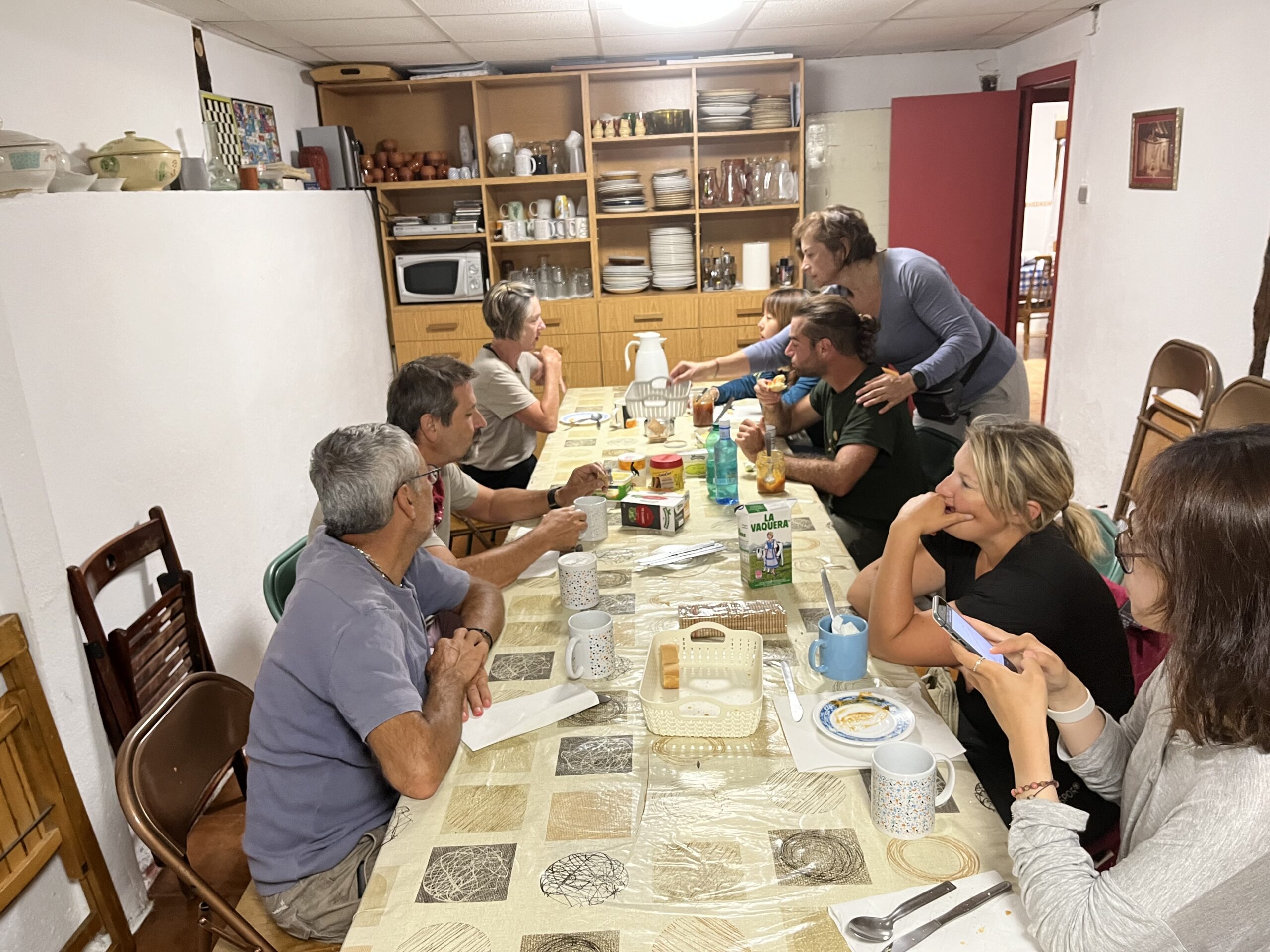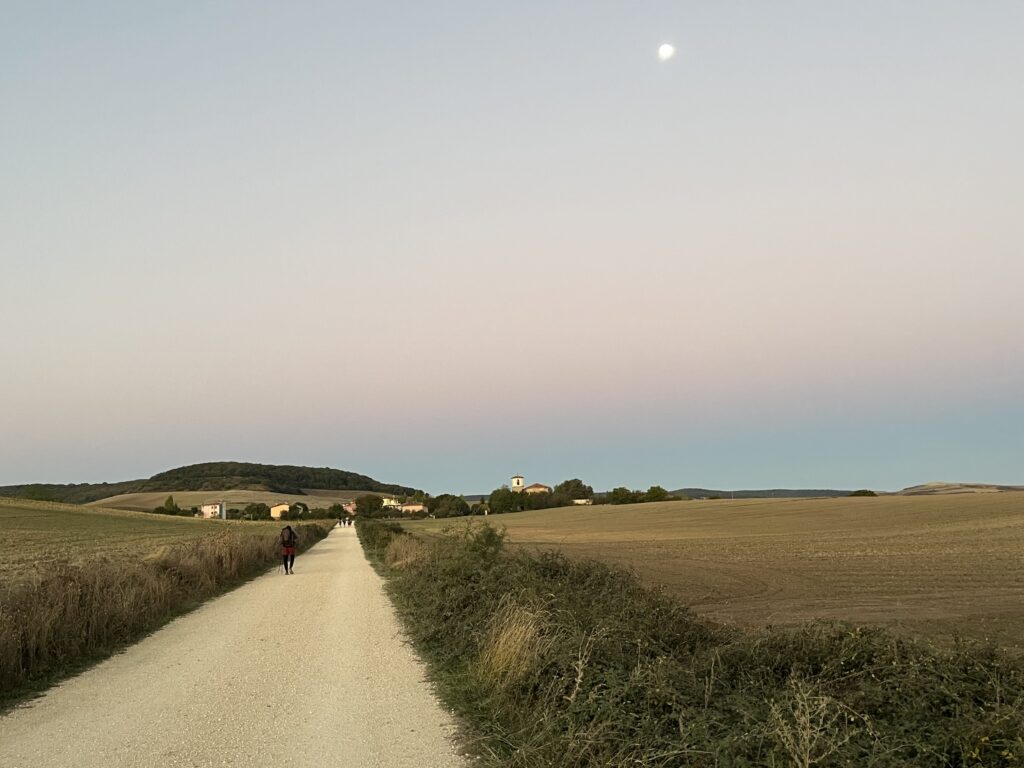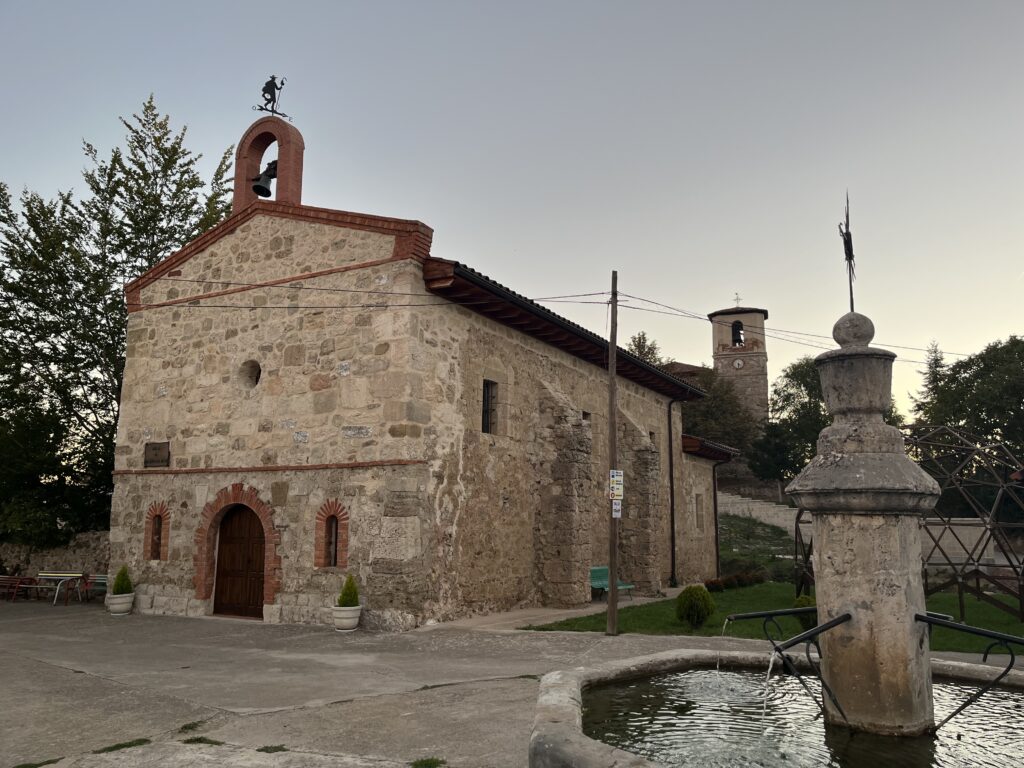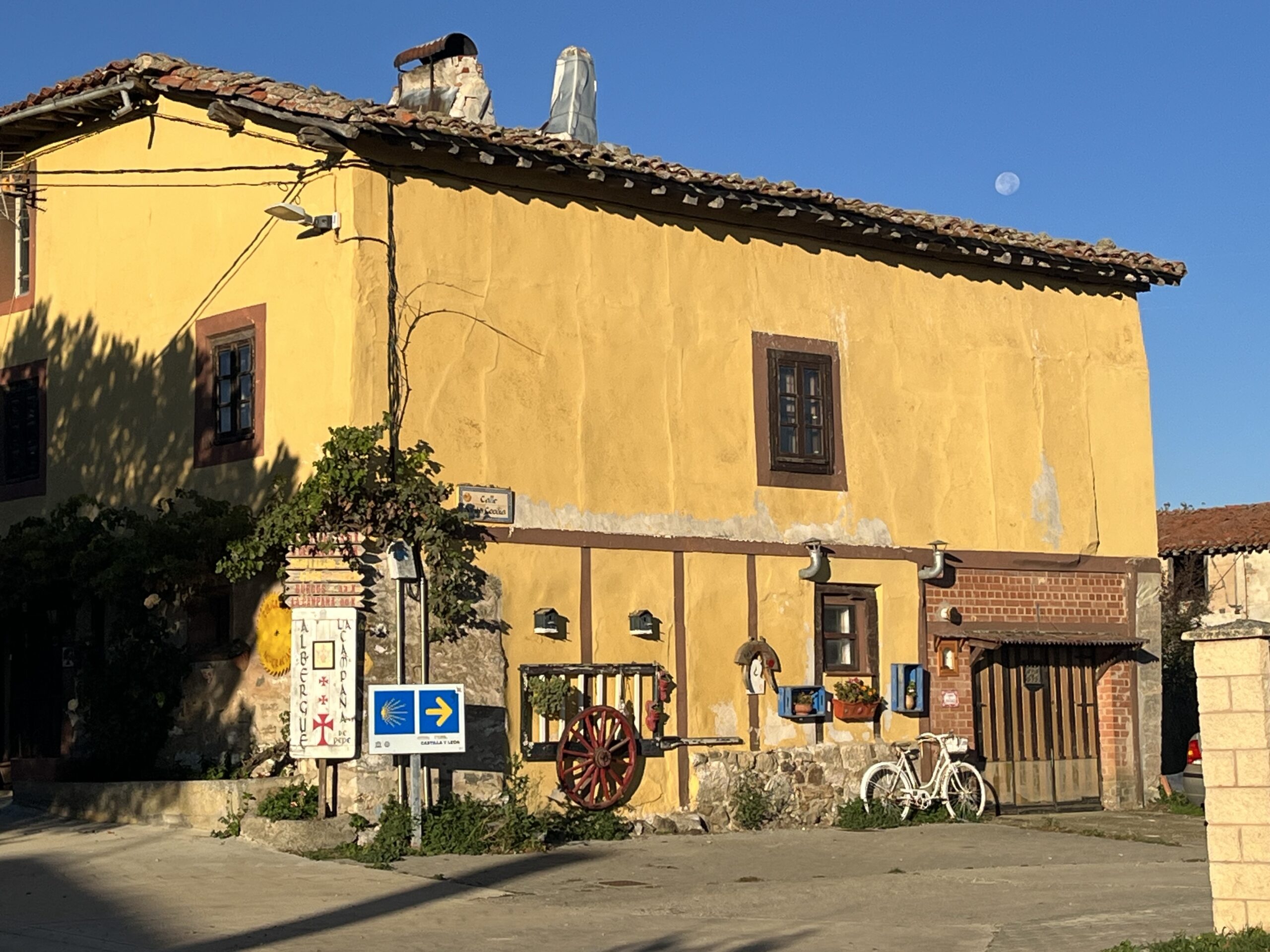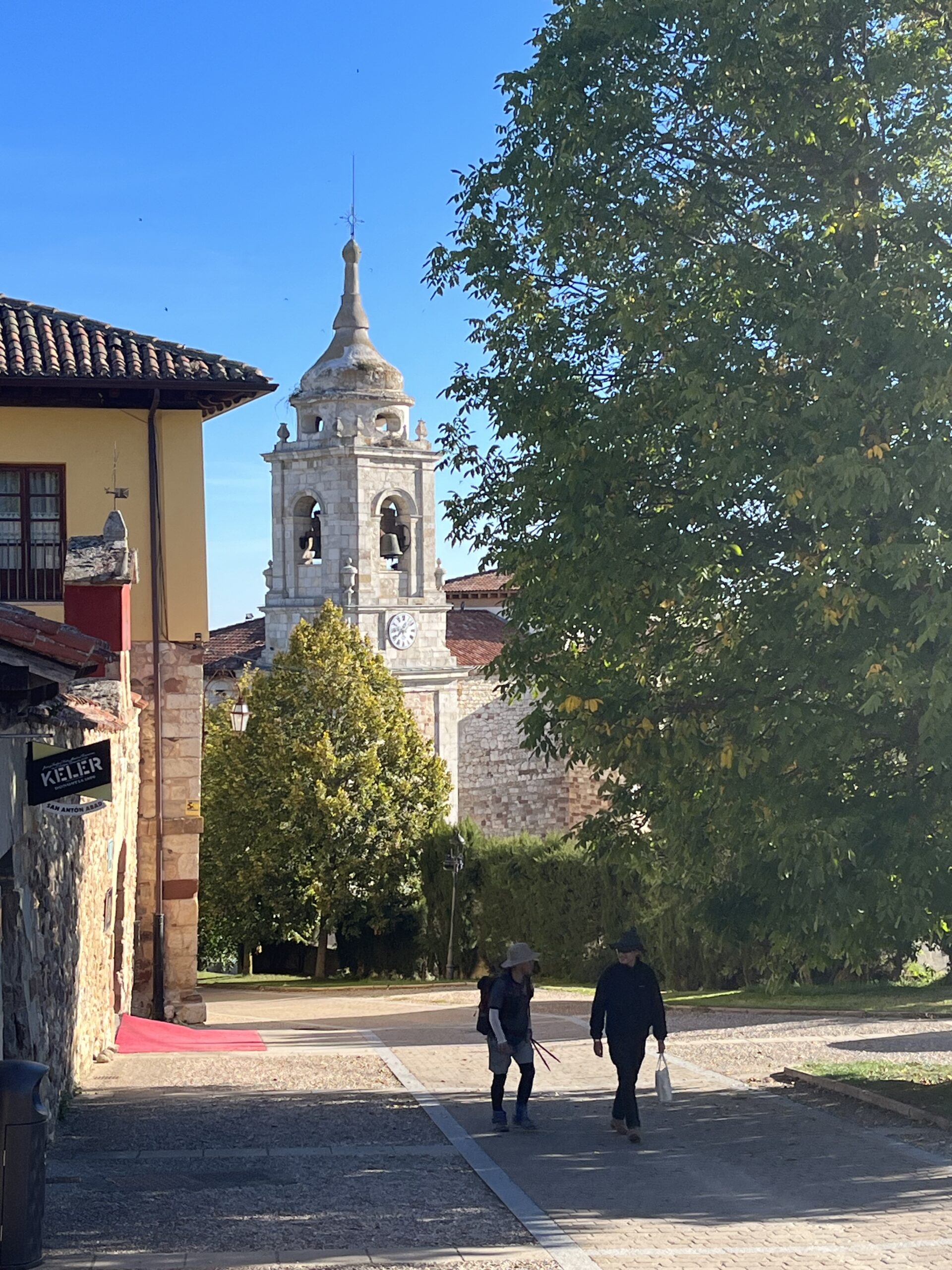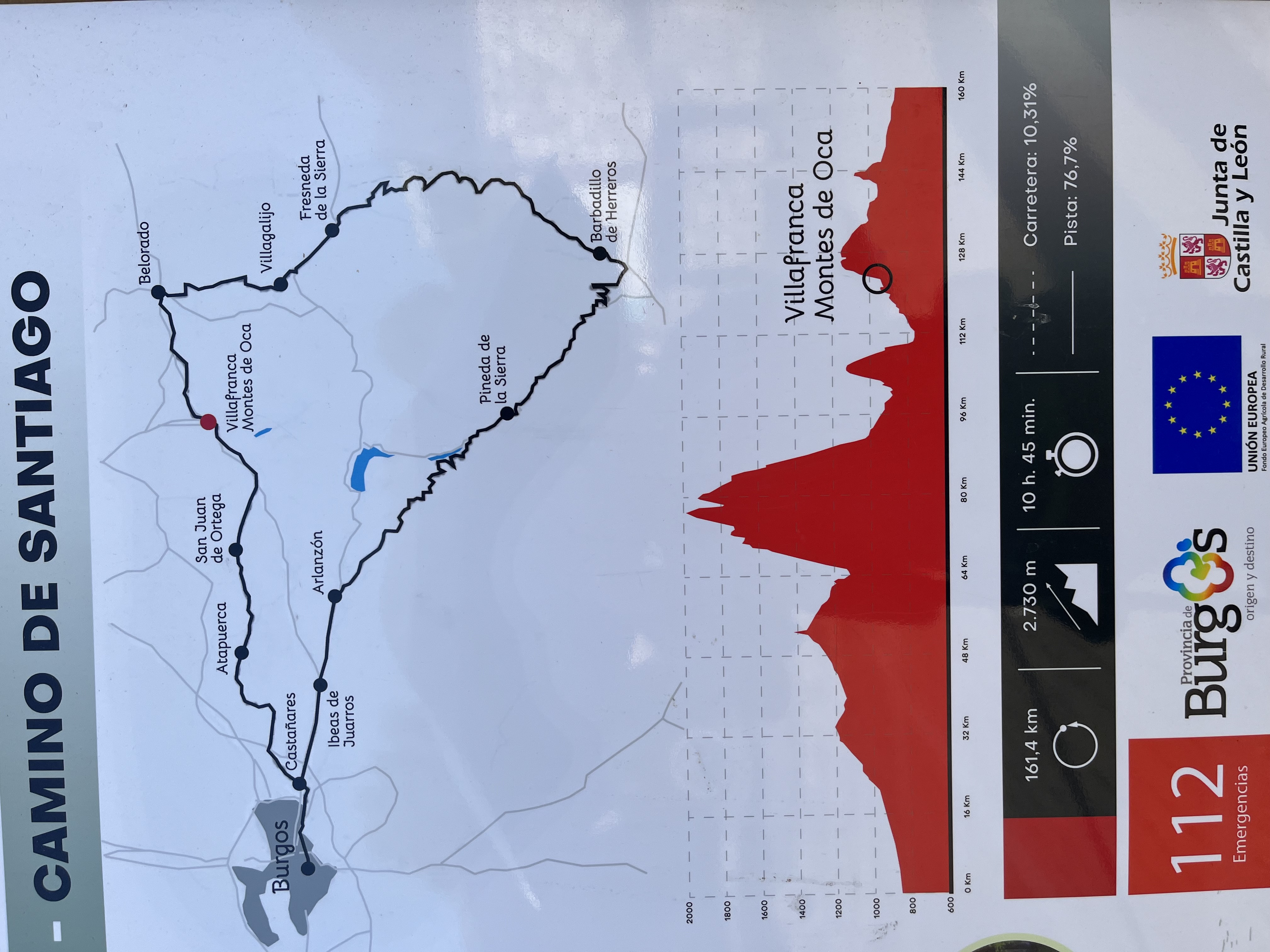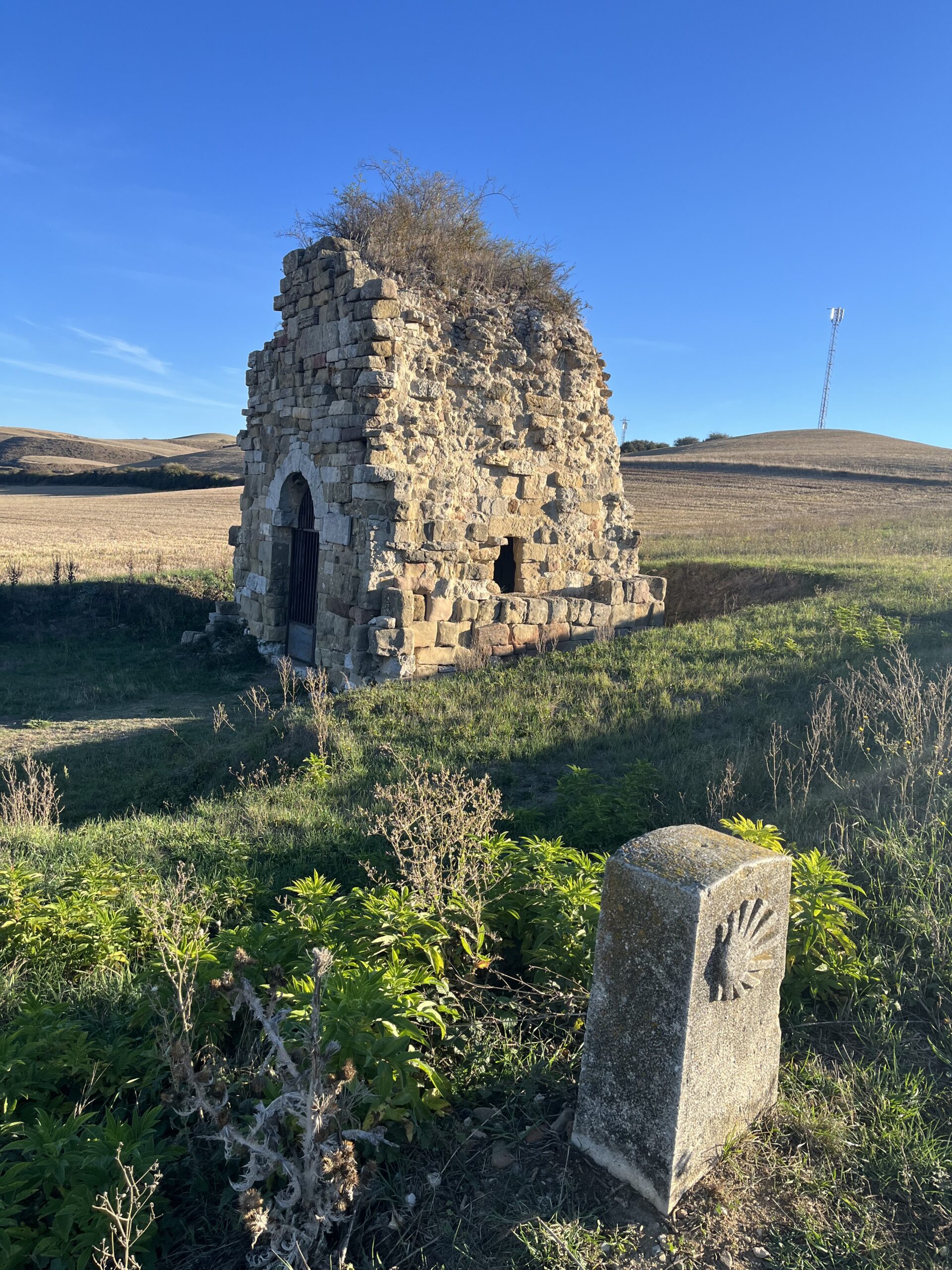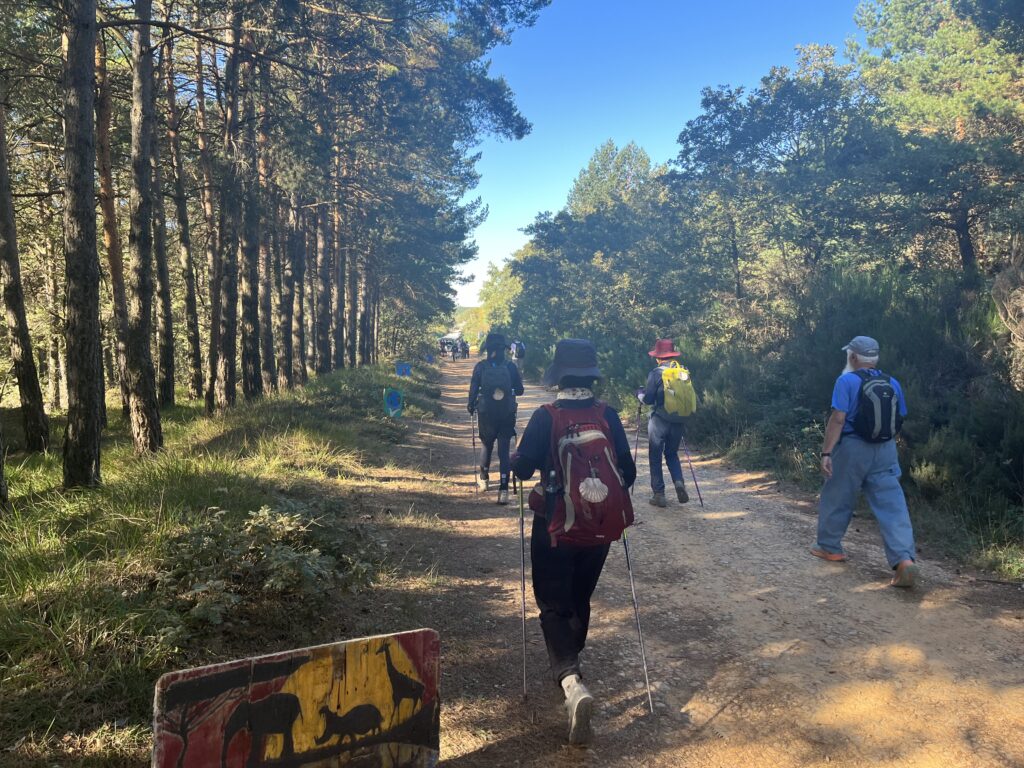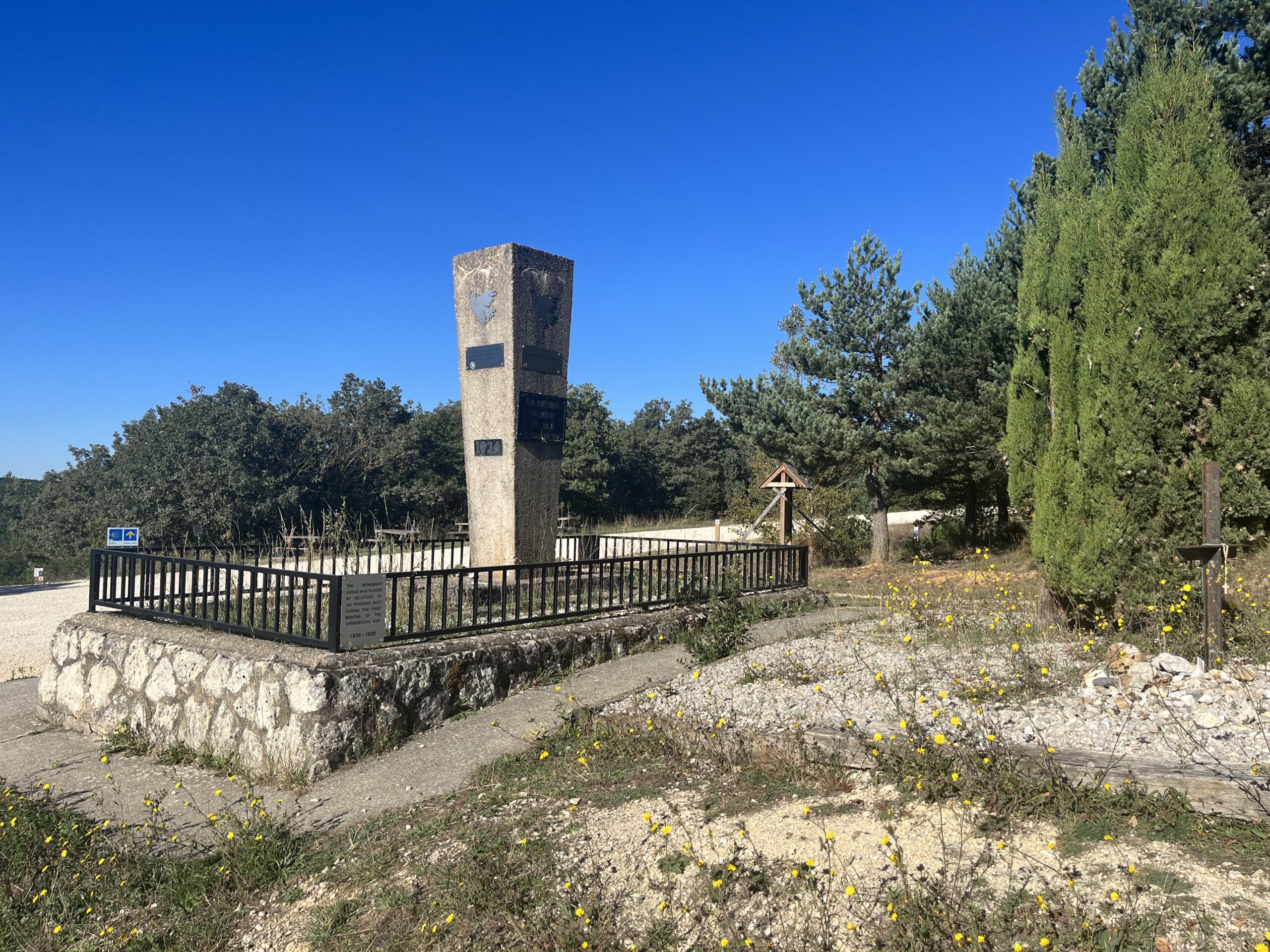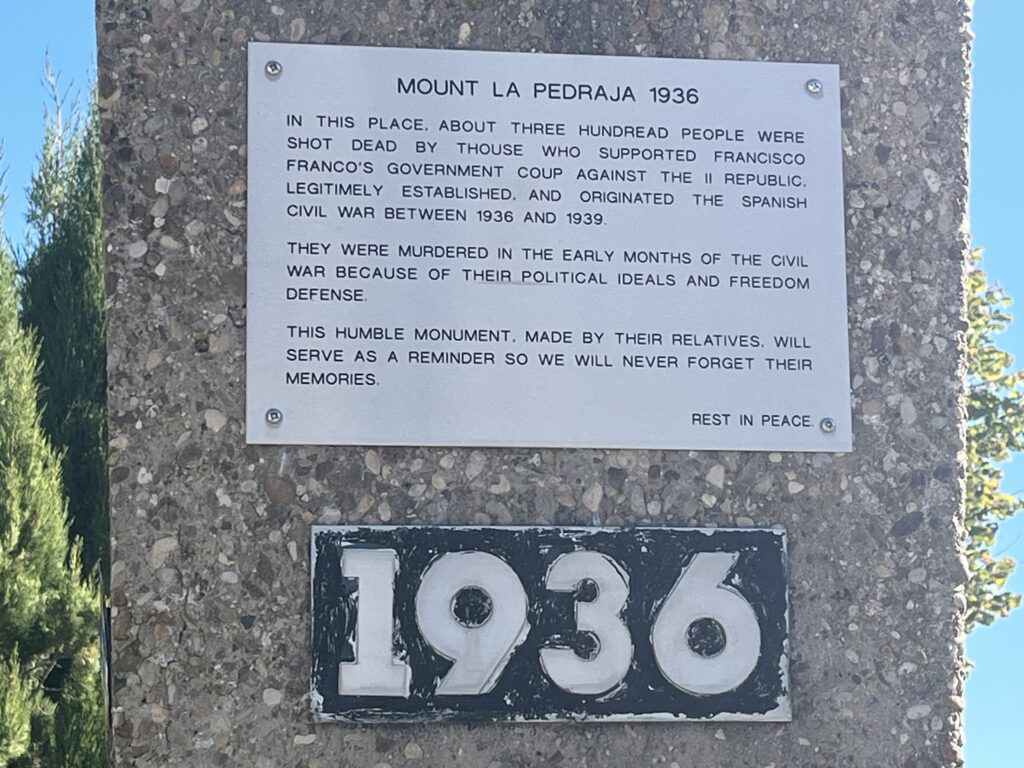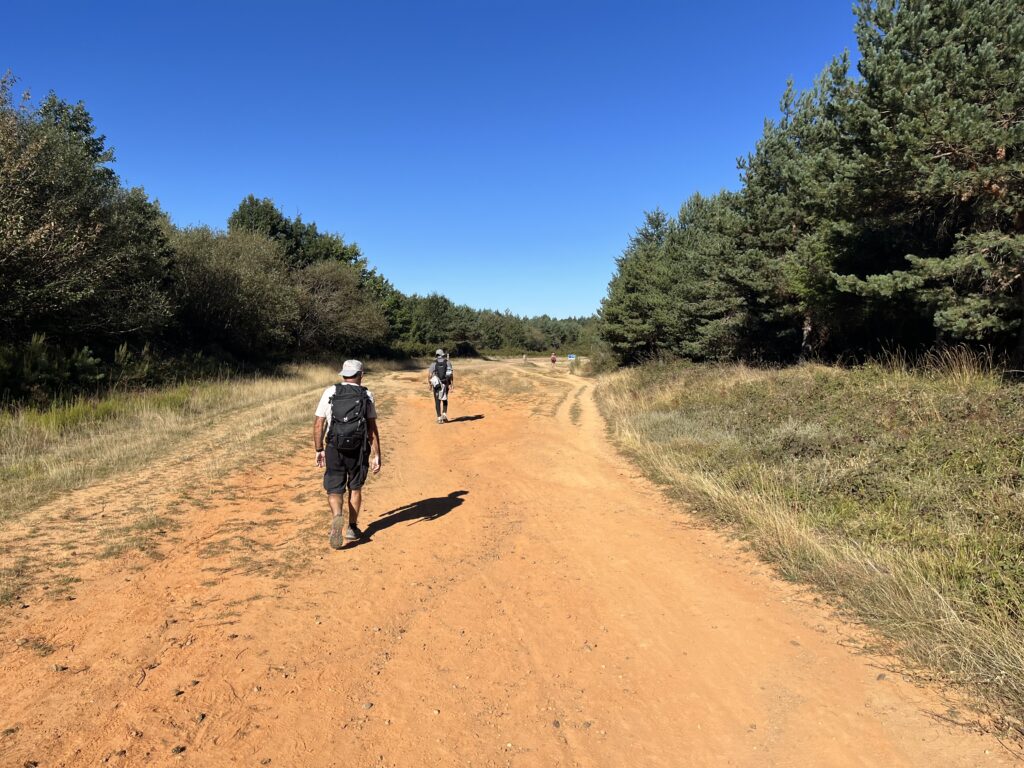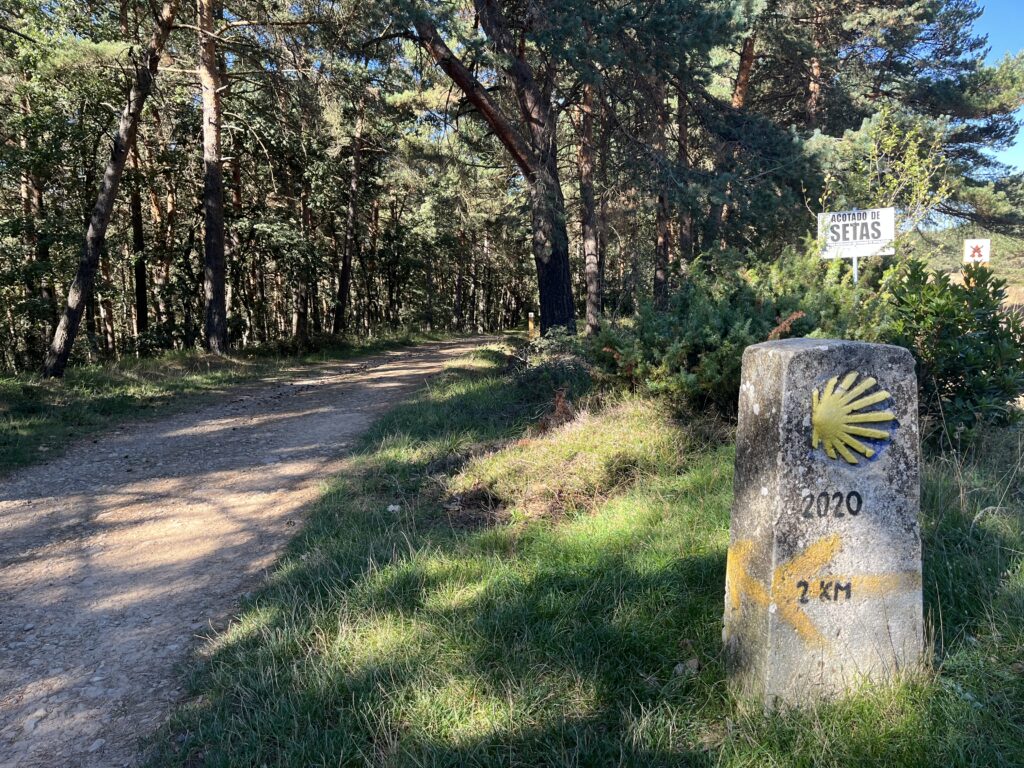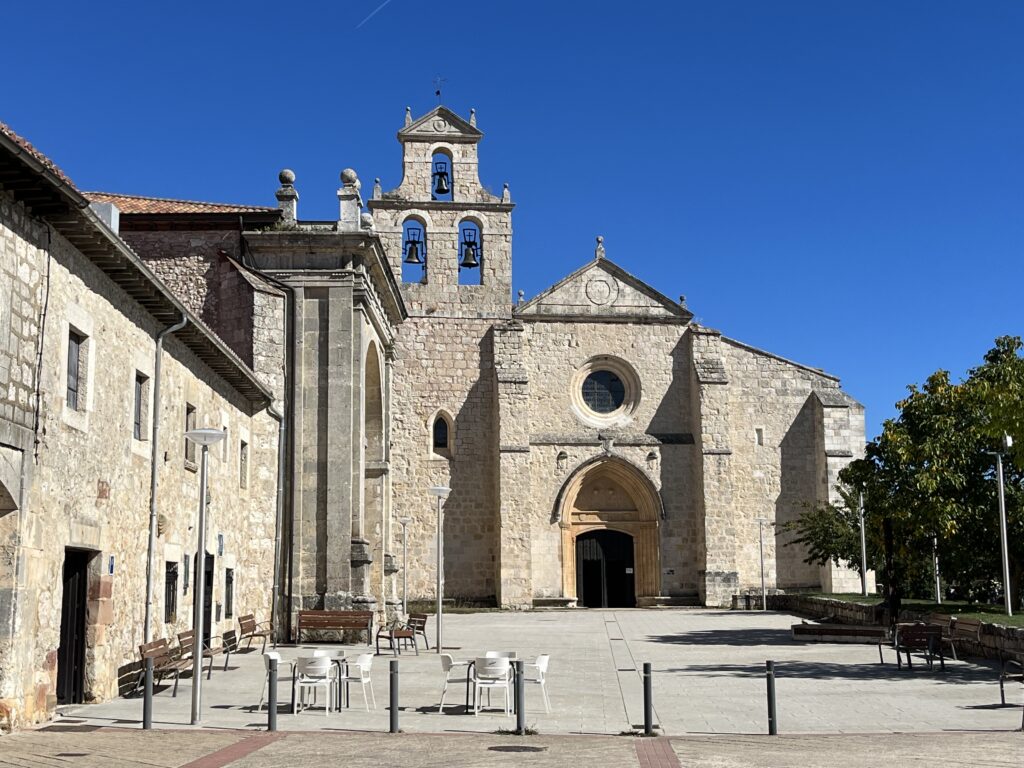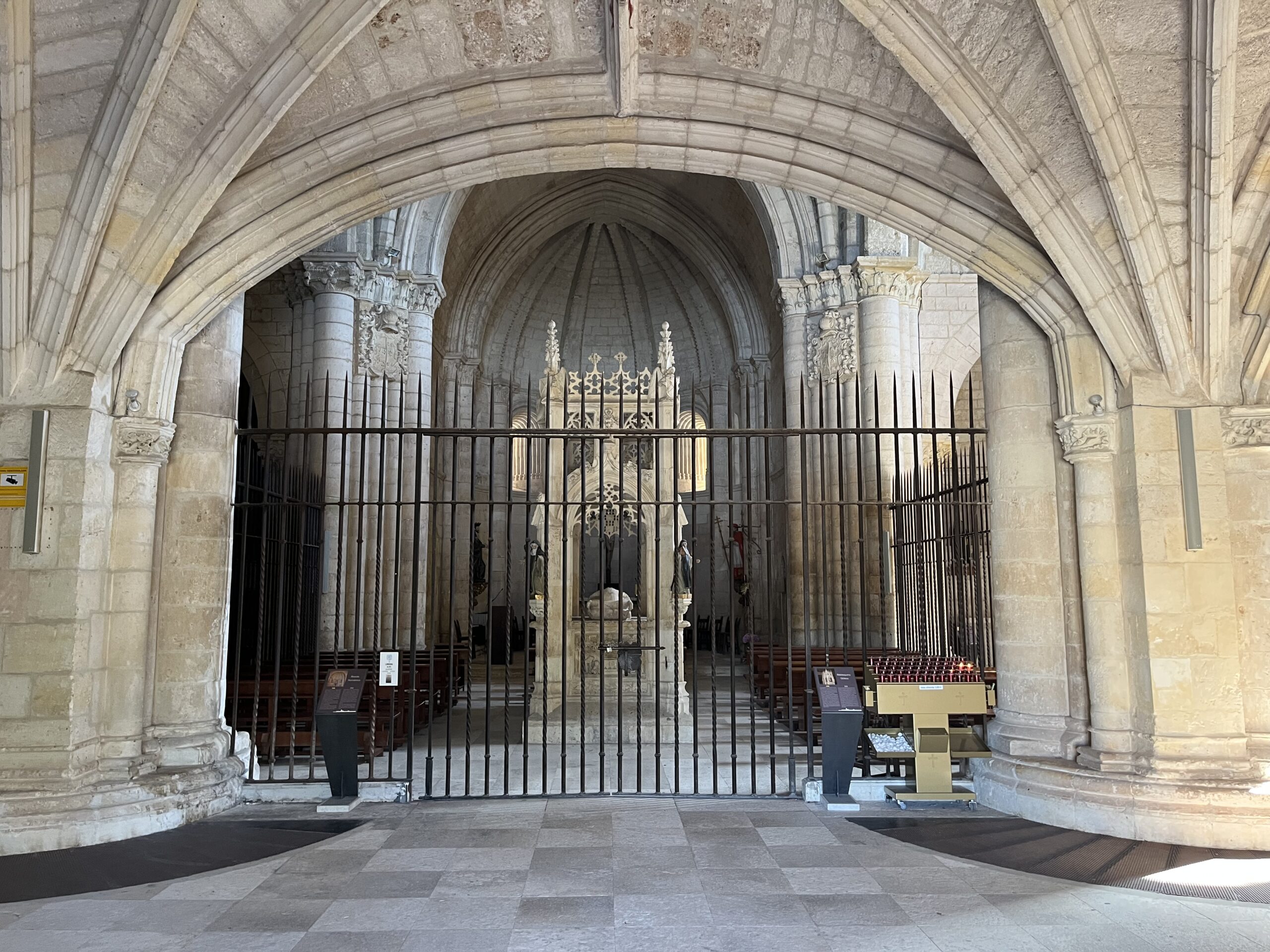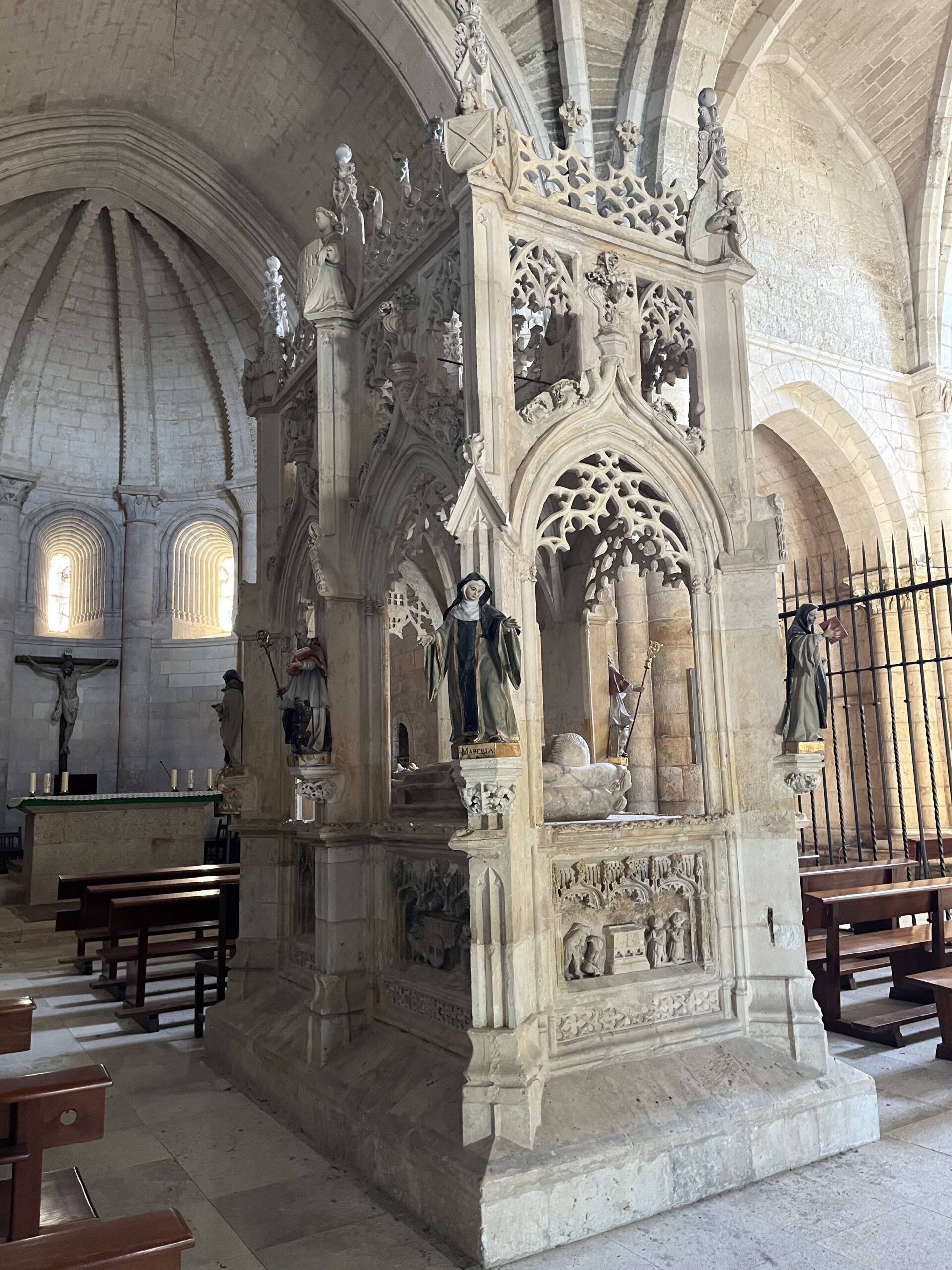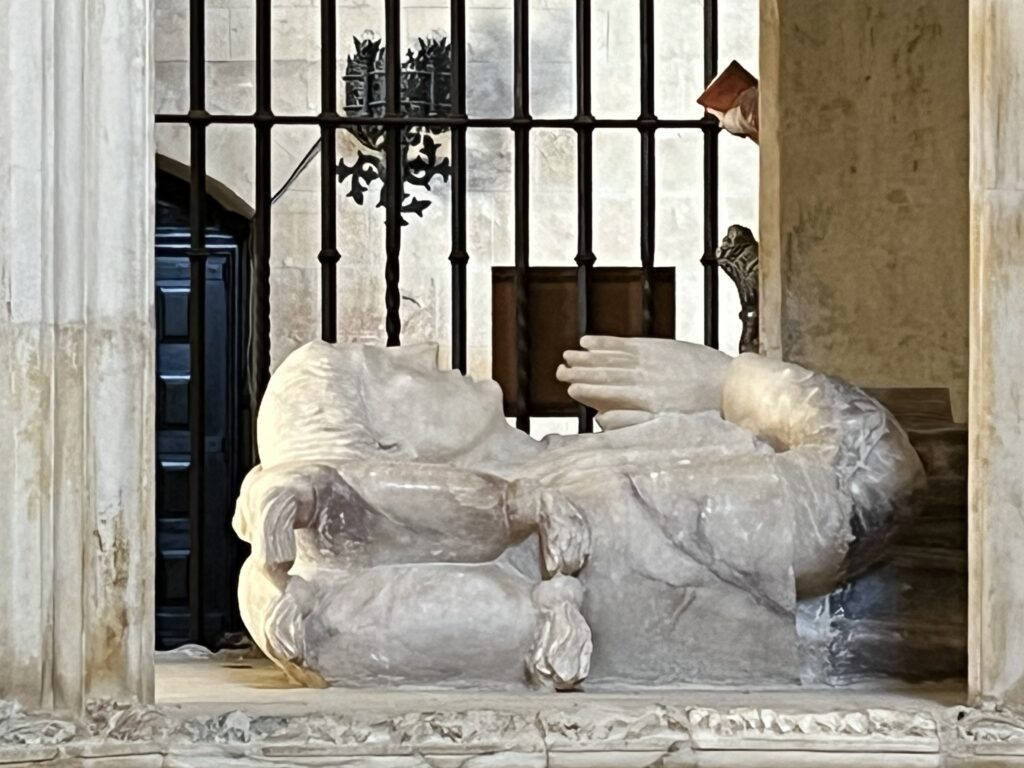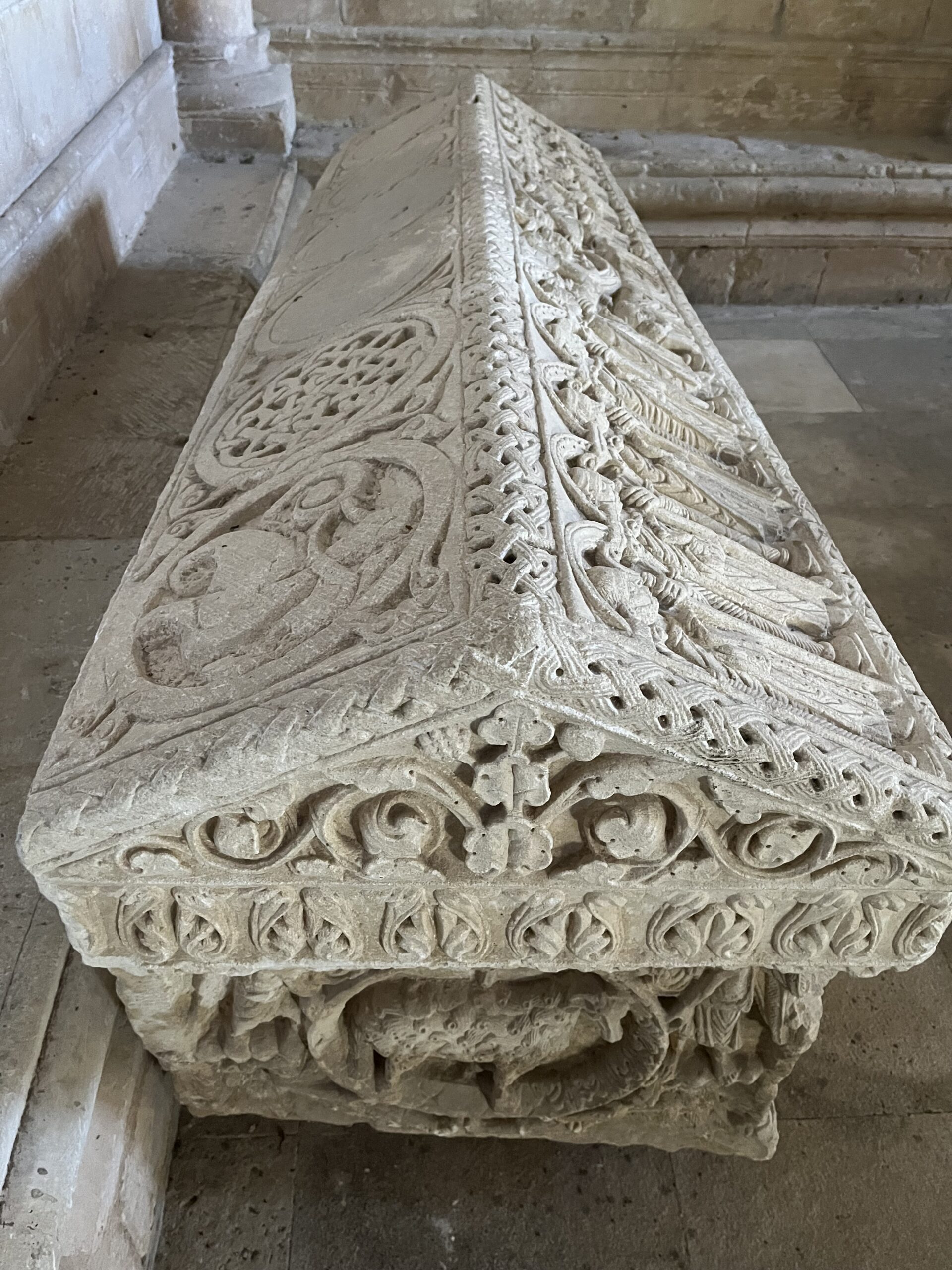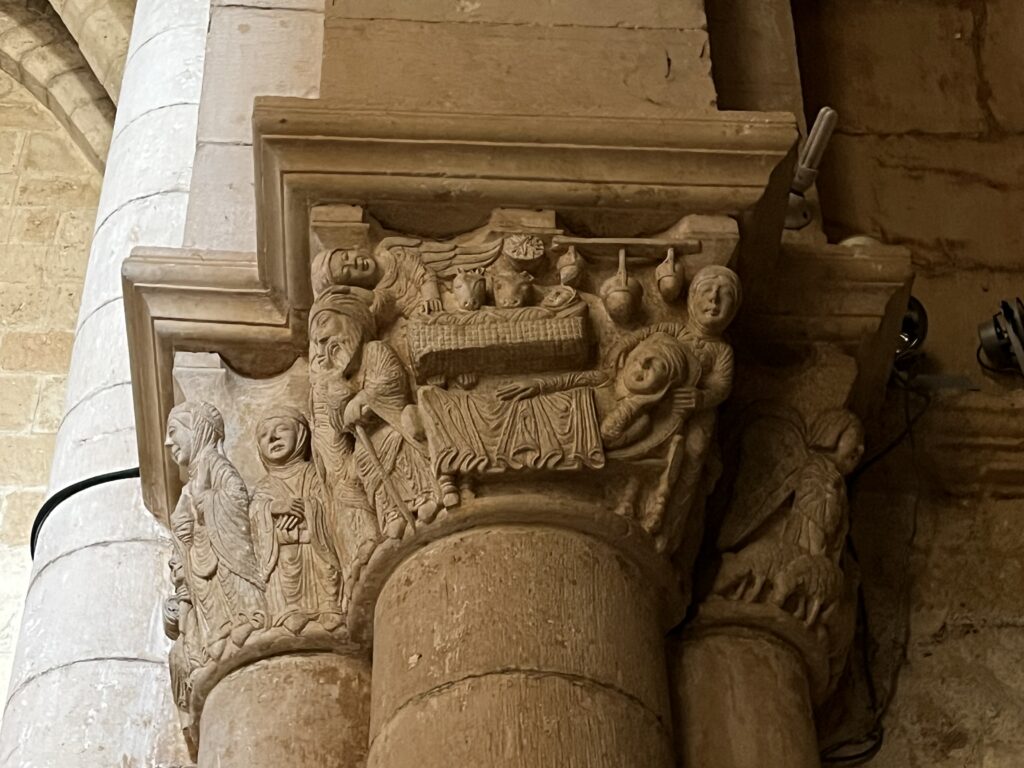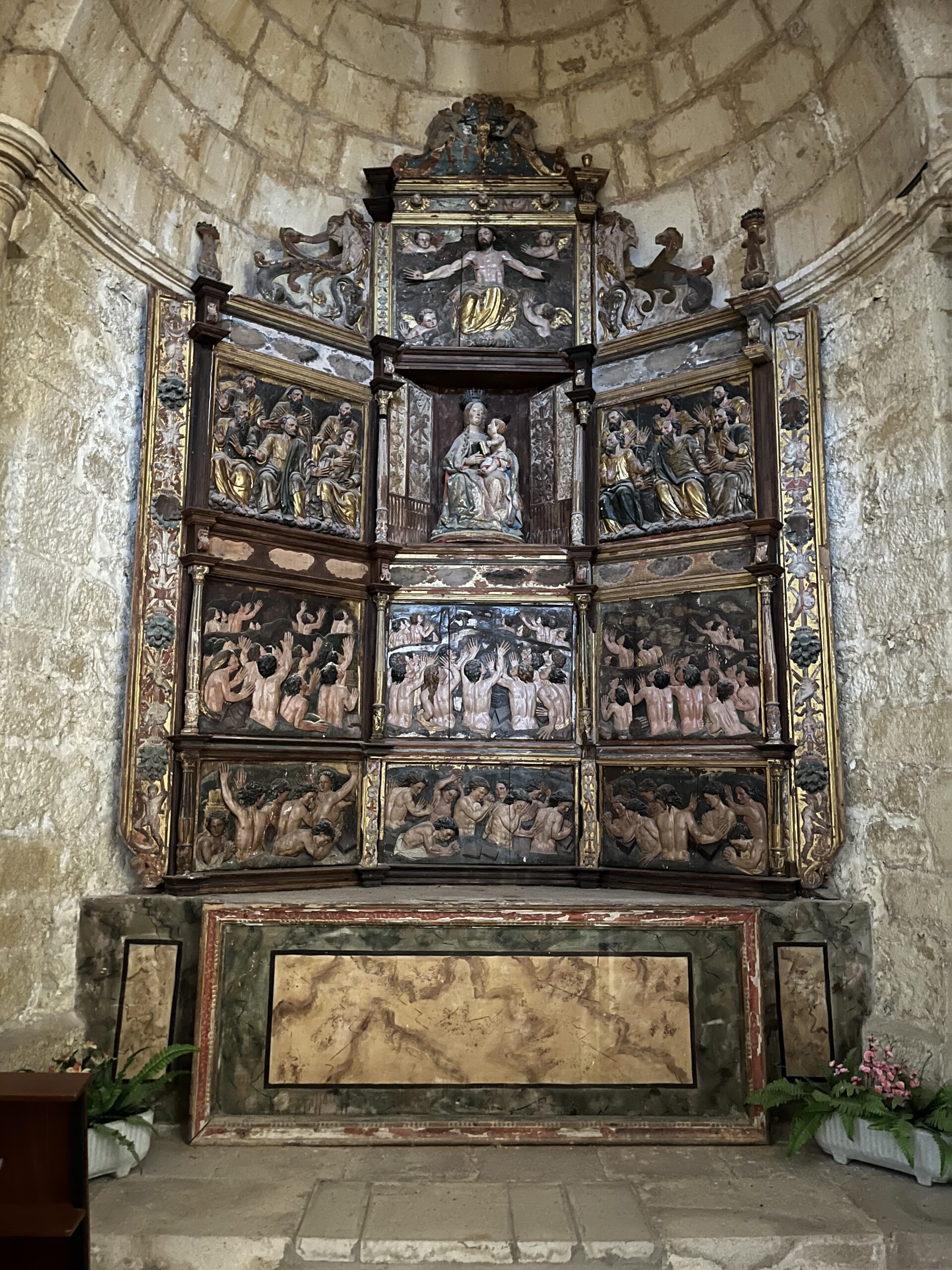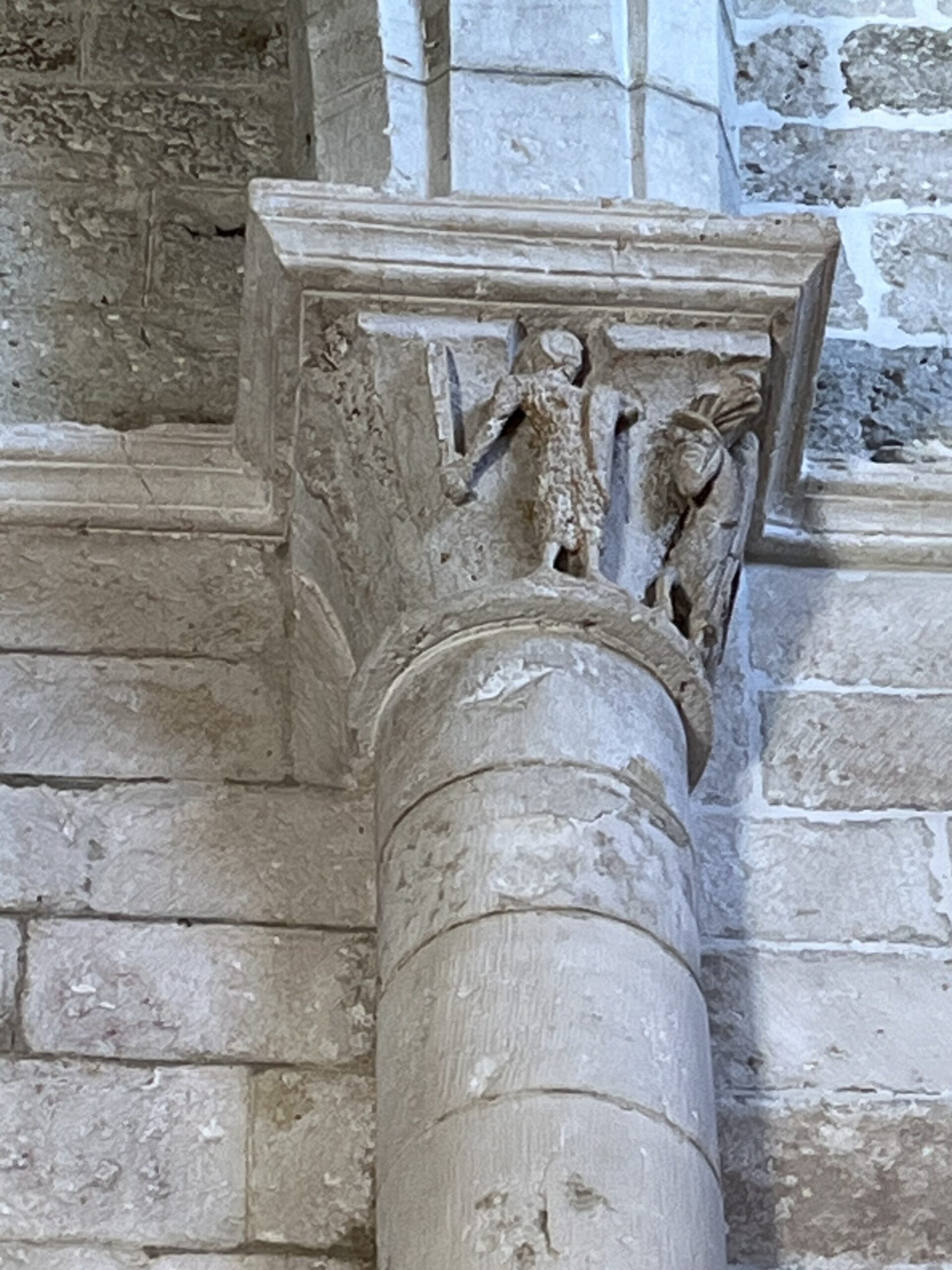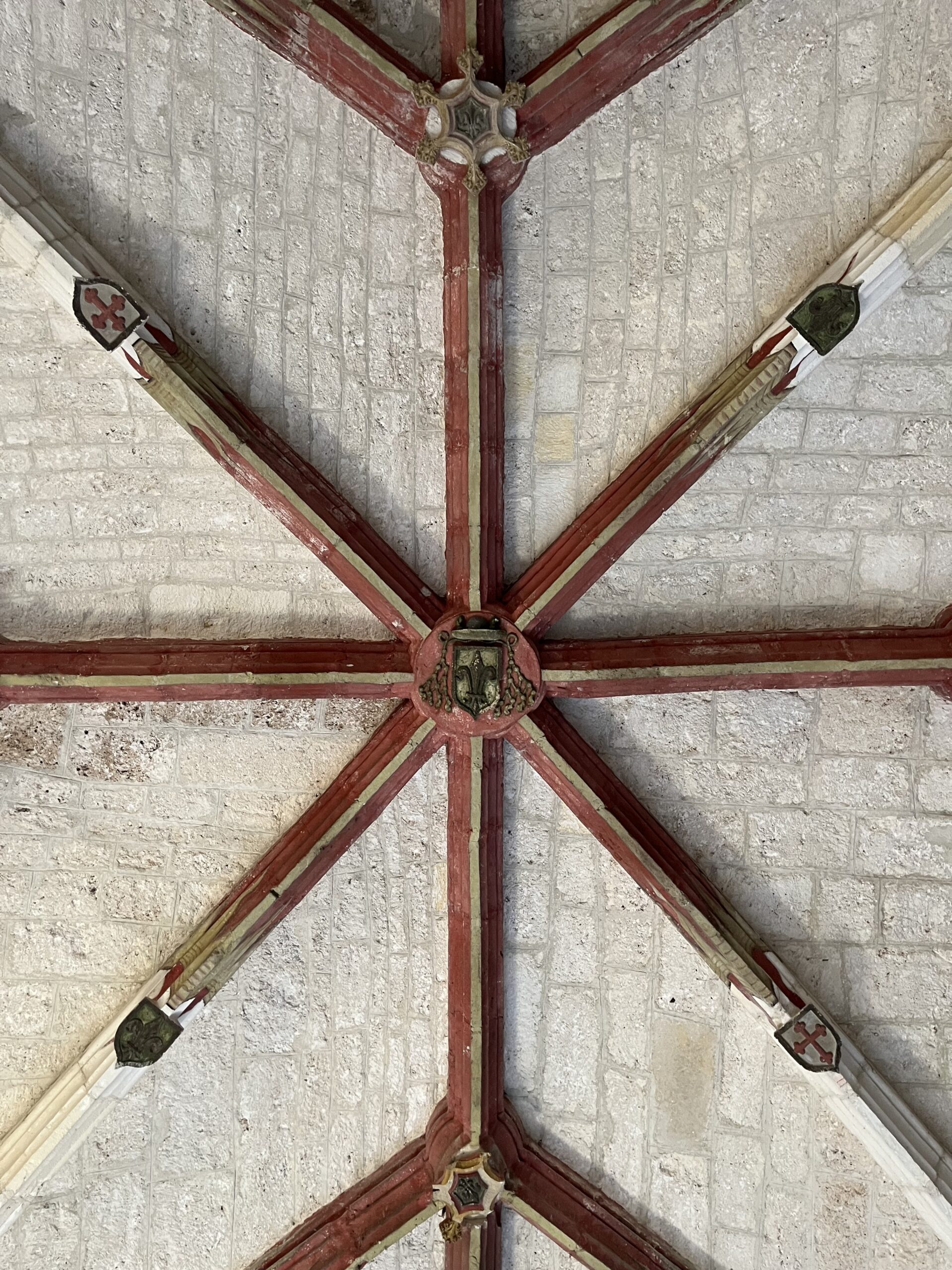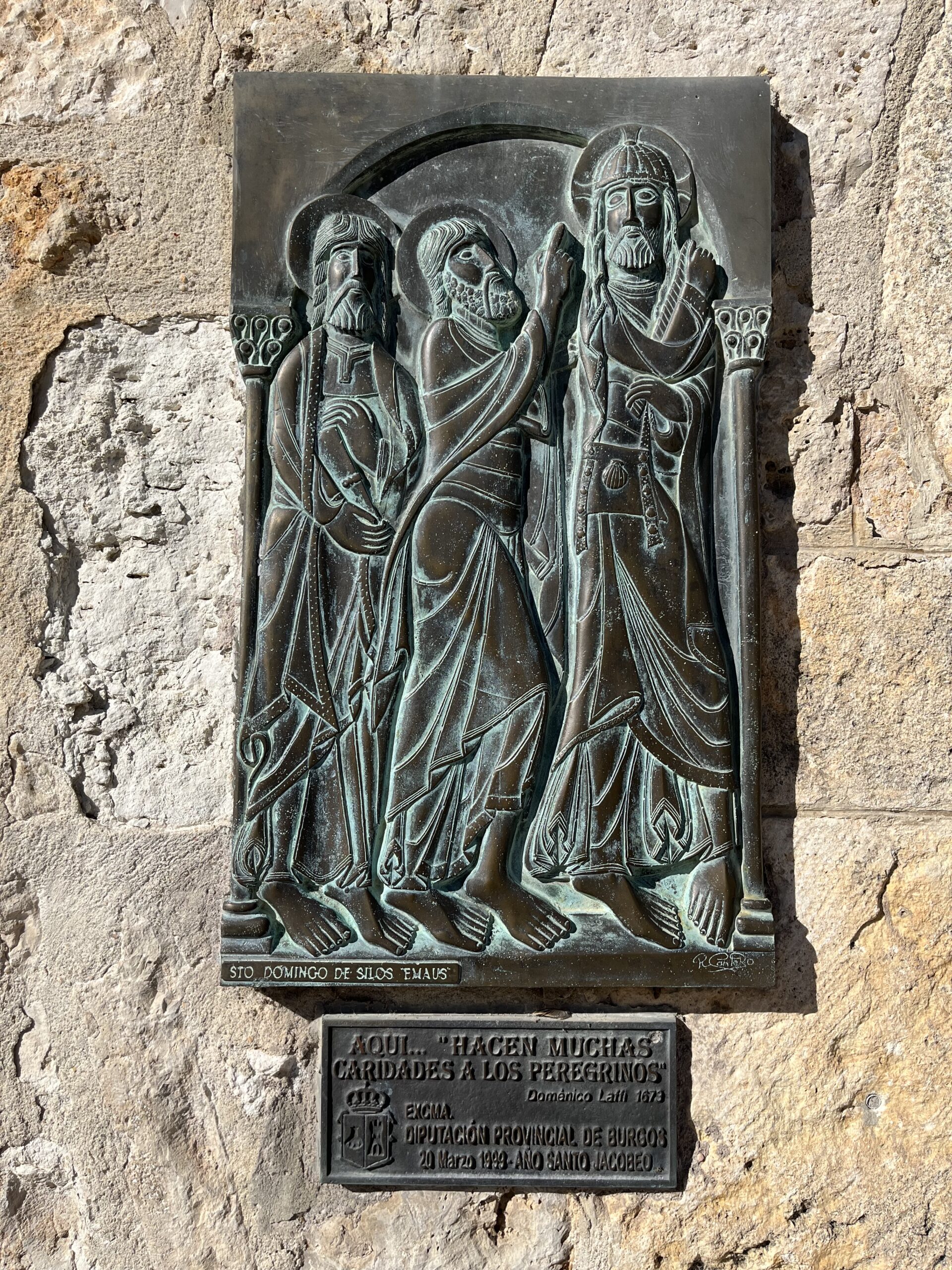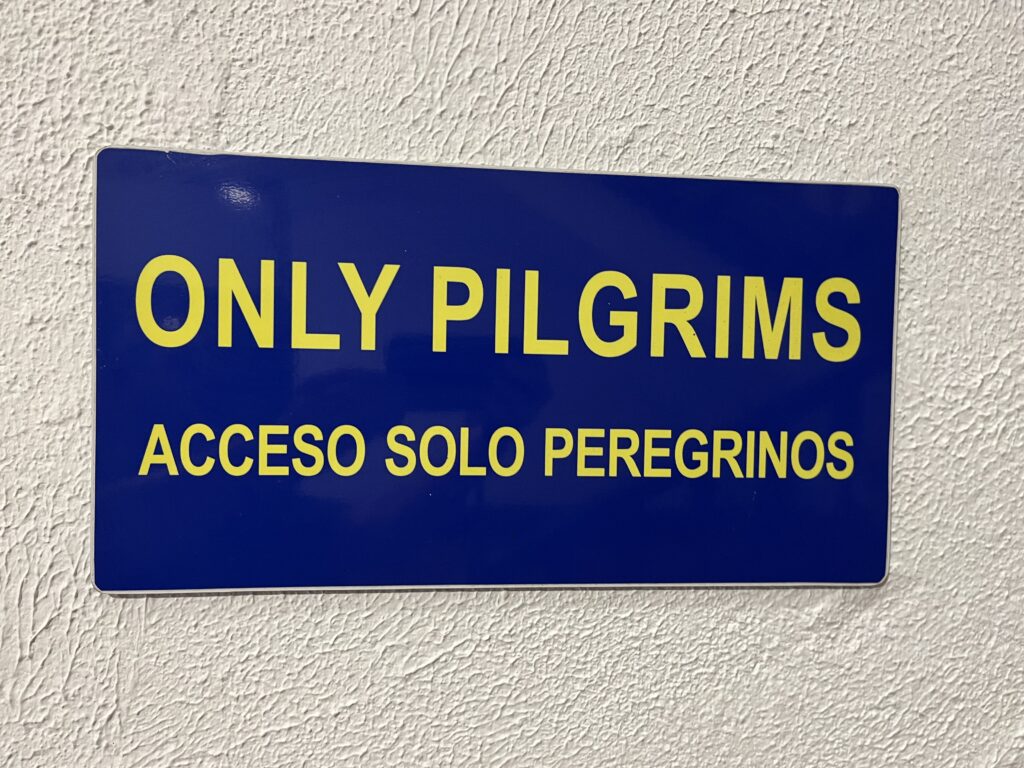Via Podiensis: Disciples
Yesterday evening, I prayed for the intentions of the Camino in an early 12th century chapel built into a cave on the site of a hermitage that was in use from the third through the sixth centuries. Since I was staying in the parroquial, they took us up to the cliff and gave us the tour.
The statue of the Virgin that forms the centerpiece of the high altar was hidden from the Muslim invaders under one of the church bells that was taken down to the valley and buried. She is known as Nuestra Señora de la Peña.
Of course, like so much else in this region of Spain, the altars and interior furnishings (and, I’m guessing, the façade) were “restored” in the early 18th century in the Baroque style. Interestingly, we know the person who paid for the restoration, because his name is inscribed on one of the side altars. The coat of arms indicates that he was an Inquisitor from the Dominican Order.
The statue of the Virgin is taken in procession to the village church each year, and it spends several months there before being taken back “home” in procession.
This morning, I slept in until about 6 AM. This particular albergue has a strict lights out policy until 6:30, so I crept out of the dormitory to pray Lauds downstairs.
Communal breakfast went long, and it was after 7:30, and dawn, when I finally left. I had to do a little hunting around to figure out where the Camino was, and I really only found it because I ran into Philipe who knew the way. Soon enough I was back on the by now usual dirt and stone and gravel road.
Uncharacteristically, when I got there there were a massive group of 12 pilgrims just ahead of me. Nine of them are from a single group traveling together from South Korea. I’ve seen them on and off since Pamplona.
Like yesterday, I was walking in the glow of a sunrise behind me and a full-ish moon ahead of me. The whole landscape of recently harvested fields fairly glowed in the golden light.
It was cool and clear, and I could already see the next little village just across the valley ahead of me.
And just so you don’t get too rosy an image of the Camino: this morning at our communal breakfast the coffee carafe broke just before it was my turn to get coffee. Finding a new carafe and making another pot of coffee contributed to this morning’s lateness.
Also, I lost my bandanna yesterday. Very inconvenient because my nose tends to run in the mornings when I’m walking in the cold air.
And I think I might be getting my first blister on the tip of one of my toes.
But of course, these are all just minor inconveniences, the sort that you run into anywhere and every day. You accept them, solve them if you can, and move on, trusting the rest to God.
It was 8 AM by the time I made it to the village of Villambistia, and I was already running almost an hour behind the schedule I had planned yesterday. So it goes.
Strangely, the village had two churches literally down the street from each other. They were both locked.
Twenty minutes later, I walked into the village of Espinosa del Camino. Much better in terms of time. I allowed myself a short break for café con leche. It was only 16 km now until the end of my short day, but I didn’t want to dawdle too long, because I knew there was a steep climb about an hour ahead of me.
As I was drinking my coffee, Tara walked up and joined me. In fact, I saw several folks from my Camino cohort during the time I was there, including Stefanie and Rebecca. Rebecca had somehow managed to fracture a finger in a grocery store yesterday, and her hand was taped up. She joked that she was fine on the Camino, but the towns were out to get her.
I also discovered that, for the first time in a long time, my tracking app glitched and turned my 4+ km so far into one.
After spending too long at the café, it was back to the Camino through the golden hills.
About 9:30, I passed what appeared to be the ruins of a small tower. In fact, these meager remains are all that is left of a once great medieval monastery and hostel.
As the moon was setting behind the hills, the Camino turned into a narrow dirt path right next to the highway leading into Villafranca Montes de Oca. The path eventually diverted from the highway and through a beautiful little stand of trees, crossing the stream on a little wooden bridge.
I entered the town about 9:45 AM and stopped at the first bar for a restroom break. I also took the opportunity to put the umbrella up.
I made the effort to visit the 18th century church of Santiago, but it was locked. It is a successor to a much, much earlier church here. Legend has it that Santiago himself ordained his disciple San Indalecio the first bishop of this place. The diocese lapsed in 8th century due to the Islamic destruction of the original town. The diocese was reestablished in 1068, but moved in 1075 to Burgos.
From here, the Camino began its long climb into the hills known as the Montes de Oca. In medieval times, this was a wild area, infested with wolves and bandits in equal measure. Hilly and heavily wooded, it was the perfect place for an ambush, and the very first pilgrim guide from the 12th century gives dire warnings about the place.
Nowadays, it’s much more sedate. I didn’t hear a wolf or see a single bandit. What I did see, though, were an awful lot of oak trees and an awful lot of hills. In some places, there was a blessedly cool and refreshing breeze, but most of the time even with the shade it was hot.
As we gained altitude, oak gradually gave way to pine.
At the very top of the hill, at about 10:50 AM, I came to a monument erected by the relatives of 300 people who were murdered there during the first months of the Spanish Civil War by Franco’s fascist forces. I prayed for the dead, and then began the long downhill track.
At the bottom, there was a little wooden bridge over the stream. And then the uphill on the other side began. It was steep, but not nearly so arduous as it looms in my memories from 2013.
The road eventually widened out, and all pretense of shade from the trees vanished. Once again, I was thankful for my umbrella.
During the course of the walk through the woods, I passed two different stands set up to sell food and drinks to pilgrims. Both of them, for reasons unknown to me, had radios blasting Spanish Pop songs at top volume. Not exactly conducive to pilgrim contemplation.
But I did see numerous butterflies flitting about in the forest today.
The road, as it continued, was badly deteriorated in sections with tread of heavy equipment dug deep in places. It finally occurred to me that what I was walking was primarily a forestry road.
At about 12:10 PM, I came out to the forest and in the distance I could see the monastery church of San Juan de Ortega. I think my pace picked up a little at that point.
The old monastery is built on the site of San Juan’s Hermitage. He was a disciple of Santo Domingo de la Calzada, and he helped him in his work to make life easier for the pilgrims. Whereas Santo Domingo is most famous for building bridges, San Juan is very much responsible for carving out the road that I walked today.
I arrived at the old monastery at about 12:15 PM or so. In the last ten years, this place has seen immense growth and restoration. I’m pretty sure that when Eamon and I arrived here in the pouring rain ten years ago, for example, the church didn’t actually have doors on it.
The albergue was not scheduled to open until 1 PM, and so I visited the church first. It has been completely restored. I will have to compare my photos when I get home, but my memory of the place is that there was no piece of furniture left, the altars were in a state of disrepair, and the saint’s tomb was sitting alone and isolated in the middle of the church.
Basically, none of that is true now. I wandered around, amazed at the change from what I remembered. Collecting myself, I prayed for the intentions of the Camino.
I should point out that this monastery hasn’t actually functioned as a monastery for quite some time. All of the buildings were seized by the Spanish state in the 19th century and sold off. Only the monastic church and the chapel next-door, which now functions as a parish church, were returned.
Today I’ve been thinking a lot about followers, and what it means to follow someone or something. On the one hand, you have San Indalecio, the follower of Santiago, and San Juan the follower of Santo Domingo. And of course, all were disciples – followers – of Christ. They all fulfilled that mission in very different ways: all in preaching and teaching certainly, but also in dying for His holy Name, in founding churches, and building bridges and roads for the ease and comfort of pilgrims.
And on the other hand, you have Franco’s fascist followers, many of whom also believed themselves to be good sons of the Church and followers of Christ. That they could commit atrocities with a clear conscience speaks to the danger of following false philosophies and movements.
And then there’s a matter of the Dominican inquisitor I learned about yesterday evening. The Spanish Inquisition (though continually denounced by Roman authorities) functioned for hundreds of years as an arm of the Spanish State, guilty of unspeakable acts of repression and murder.
In context and in the heat of the moment, we are all capable of sin and brutality.
I think what I’m coming to, in my own roundabout way, is the idea that discipleship requires discernment. Or, possibly, “put not your trust in princes”.
Date: 01 October 2023
Place: San Juan de Ortega
Today started: Tosantos
Today’s Photos!
